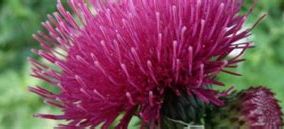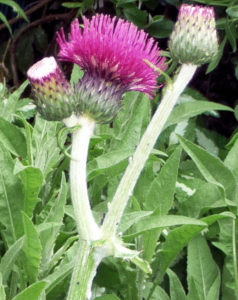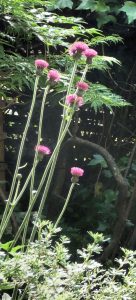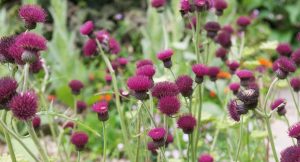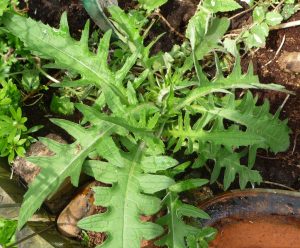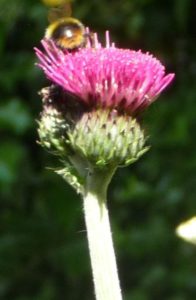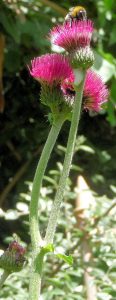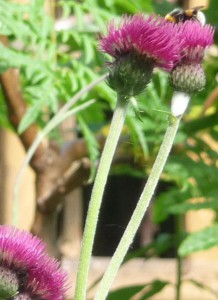CIRSIUM RIVULARE ‘Atropurpureum’ (Brook Thistle)
Central & Southern Europe to Russia
Cirsium rivulare ‘Atropurpureum’ is an ornamental thistle which grows halfway round the planet in many countries, as shown below by its ‘other names’.. This hardy, semi-evergreen perennial prefers moist conditions in neutral or acid soil… ‘rivulare’ means ‘brook loving’.
From a basal rosette of dark green foliage the Brook Thistle sends up spiny stems that may reach 4 to 5 feet in height. rich WINE RED flowerheads appear at the tops of the stems; they bloom from June to September.
The plant is hardy & semi evergreen. Cut it back in autumn to prevent seeding, or leave intact to provide food for birds over winter. Lift and divide congested clumps in spring.
The Royal Horticultural Society rates Cirsium rivulare ‘Atropurpureum’ ‘RHS PERFECT FOR POLLINATORS’. In our Highbury garden in 2015, bees quickly discovered the first Brook Thistle to come into bloom. Throughout the growing season bees were plentiful, with several bees at a time competing for landing space on the thistle heads, and Bumblebees browsing there for quite a time.
‘Handsome, long-flowering, easy, healthy, and loved by our pollinating insects – if you don’t already have it in your garden, you should!’ Sarah Raven http://www.sarahraven.com
Other names: Plume Thistle, Cirse des ruisseaux (French), Bachdistel (German), Cardo dei rivi (Italian), Cardo muelle de arroyo (Spanish), Cirze e krojeve (Albanian), Cardigassa rivular (Catalan), Potocni osjak (Croatian), Pchac potocni (Czech), Csermely acat (Hungarian), Paupine usnis (Lithuanian), Ostrozen takowy (Polish), Scai de ape (Romanian), Pichliac potocny (Slovak), Potocni osak (Slovene), Backtistel (Swedish).
Cirsium Rivulare’Atropurpurea’ at Highbury
Sarah Raven says that Cirsium rivulare ‘Atropurpureum’ was much used in Chelsea garden design ten years ago, less so now. Perhaps gardeners have had problems with the plant’s vigorous self-seeding tendencies. In our garden the wildlife usually pecks up seeds of prolific plants before they become plantlets. Come springtime 2016, , we shall see whether any baby thistles survive round the site of this year’s successful plant.
2016: No Cirsium rivulare seedlings, no new plants.
